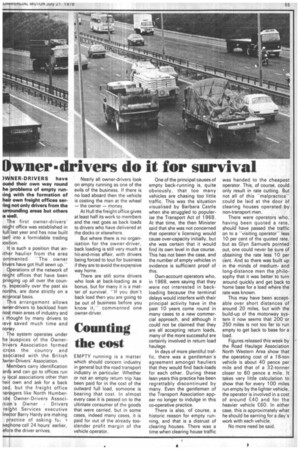Counting the cost
Page 57

If you've noticed an error in this article please click here to report it so we can fix it.
EMPTY running is a matter which should concern industry in general but the road transport industry in particular Whether or not an empty return trip has been paid for in the cost of the outward full load, someone is bearing that cost. In almost every case it is passed on to the ultimate consumer of the goods that were carried, but in some cases, indeed many cases, it is paid for out of the already tooslender profit margin of the vehicle operator. One of the principal causes of empty back-running is, quite obviously, that too many vehicles are chasing too little traffic. This was the situation visualised by Barbara Castle when she struggled to popularise the Transport Act of 1968. At that time, the then Minister said that she was not concerned that operator's licensing would cause over-capacity initially, but she was certain that it would find its own level in due course. This has not been the case, and the number of empty vehicles in evidence is sufficient proof of this.
Own-account operators who, in 1968, were saying that they were not interested in backloading because the terminal delays would interfere with their principal activity have in the past 10 years come round in many cases to a new commercial approach, and although it could not be claimed that they are all accepting return loads, many of the more successful are certainly involved in return load haulage.
In days of more plentiful traffic, there was a gentleman's agreement amongst hauliers that they would find back-loads for each other. During these lean years this practice has been regrettably discontinued by many. Even the gentlemen of the Transport Association appear no longer to indulge in this co-operative practice.
There is also, of course, a historic reason for empty running, and that is a distrust of clearing houses. There was a time when clearing house traffic
was handed to the cheapest operator. This, of course, could only result in rate cutting. But not all of this "malpracticecould be laid at the door of clearing houses operated by non-transport men.
There were operators who, having been quoted a rate, should have passed the traffic on to a "visiting operator" less 10 per cent of the quoted rate, but as Glyn Samuels pointed out, one could never be sure of obtaining the rate less 10 per cent. And so there was built up in the minds of mediumand long-distance men the philosophy that it was better to turn around quickly and get back to home base for a load where the rate was known.
This may have been acceptable over short distances of around 20 miles, but with the build-up of the motorway system it now seems that 200 or 250 miles is not too far to run empty to get back to base for a load.
Figures released this week by the Road Haulage Association North Western Area show that the operating cost of a 16-ton vehicle is about 40 pence per mile and that of a 32-tonner closer to 60 pence a mile. It takes very little calculation to show that for every 100 miles run empty by the lighter vehicle, the operator is involved in a cost of around £40 and for the heavier vehicle £60. In either case, this is approximately what he should be earning for a day's work with each vehicle.
No more need be said.




































































































